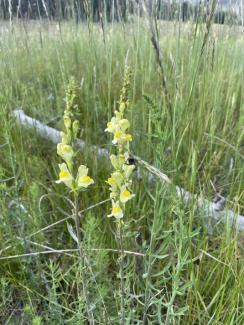Exotic and Invasive Species
Noxious weed species compete with native plants for sunlight, water, and nutrients which can threaten the ecological integrity of plant communities on the forest. They can be spread by vehicles, equipment, pets, pack animals, shoes, and more. Do your part by becoming familiar with some of the most common noxious weeds on the forest, listed here. Other best practices include: avoid recreating in areas infested with noxious weeds and clean your hiking boots, vehicles, equipment, and animals before and after each trip whenever possible.
Common Invasive Plant Species Found on the Rio Grande National Forest
Cheat grass an annual grass that emerges early in the spring and dies off in the summer. This life cycle allows it to capitalize on precious resources (i.e. water & nutrients) before native plants emerge. By drying out early in the season, it also becomes a source of fine fuel which is highly flammable. Cheatgrass seeds can remain viable in the soil for approximately three years and easily hitch hike on socks, fur, and clothing.

Yellow toadflax Linaria vulgaris - An aggressive perennial forb that displaces native vegetation. Removing this species by hand is typically ineffective as it has an extensive root system that can resprout if all material is not removed.
Houndstongue Cynoglossum officianale – A biennial forb that produces rosettes (basal leaves) during its first year and flowers the second year. Seeds have small appendages that allow it to easily hitchhike on socks, clothing, and fur
Black Henbane Hyoscyamus niger – An annual or biennial forb that can grow up to 3 feet tall. Flowers are cream-yellowed colored with a reddish center and distinct veins on the petals
Oxeye daisy Leucanthemum vulgare – As the name implies, this species has a daisy like appearance with white ray flowers and yellow disc flowers in the center. This perennial forb spreads aggressively through its root system, making manual removal methods difficult. Additionally, seeds can remain viable in the soil for 38 years.

Musk thistle Carduus nutans – A biennial forb that produces rosettes (basal leaves) during its first year and flowers the
second year. It can grow up to 6 feet tall and produce thousands of viable seed. It is characterized by bright pink-purple flowers and wide, spine tipped bracts that surround the flower.
Invasives Resources
For more information on invasive species, visit these resources.
- USFS invasive main page
- Rio Grande National Forest - Invasive Species Project on iNaturalist
- EDD Maps
- Colorado Noxious Weeds



